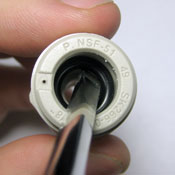Pure Water Occasional. March, 2025
|
In this early Spring Occasional you'll hear about quick connect water filter fittings, John Guest, dermal absorption of fluoride, residential water treatment for PFAS, "The Greatest and Most Consequential Day in U. S. History," James G. Watt, a promise to "drive a daggar through the heart of climate change religion," how road salt threatens drinking water, the consequences of retreating glaciers, how bottled water companies are robbing us blind, more changes to the "Waters of the United States," the impending dry-up forcast for Texas, the world leader in plastic contamination of drinking water, the comeback of Acid Rain, how pig farming is ruining the drinking water of Galicia, how to keep your private well safe, and, as always, there is much, much more.
Thank you for reading, and sincere thanks from Pure Water Products for your continuing support. |
|
Thanks for reading!
Please visit the Pure Water Gazette, where you will find hundreds of articles about water and water treatment, and the Pure Water Products main website, where there is much information about water treatment and specific information about the products we offer. On both of these information-rich sites, pop-up ads and other distractions are not allowed.
|
Pure Water Annie’s FAQ Series
Pure Water Gazette Technical Wizard Pure Water Annie Answers All the Persistent Questions about Water Treatment.
Quick Connect Fittings
Why do they call these things John Guest fittings?
The
British company, John Guest, was the originator of the popular quick
connect fittings used almost exclusively in small water filtration
equipment these days. In the same way that all soft drinks are referred
to as “cokes,” the brand name John Guest has become generic. Actually,
there are several very good brands of “John Guest” fittings on the
market.
How do they work?
When
a piece of tubing is inserted into the fitting it passes through an o
ring and is grabbed and held tightly in place by metal teeth that are
mounted on a small collar called a collet. The tube is held tightly by
the collet. Outward pressure makes the fitting tighter–something like a
Chinese finger puzzle. It’s the small o ring that makes the seal. The
metal teeth on the collet hold the tube in place. To release the tube,
push in on the collet toward the body of the fitting and at the same
time pull out the tube.
Do they leak?
Yes,
but not often. They’re probably more reliable than standard threaded
compression fittings because they aren’t as susceptible to installer
error. Best of all, leaks are usually small drips–not the catastrophic
blow-outs you can get with a poorly installed compression fitting.
What causes leaks?
New
fittings seldom leak. Usually leaks occur after o rings in the fittings
have been degraded by chemicals (chloramine is the worst) or by
physical stress caused by improper placement. For example, if the
installer fails to leave enough “slack” in a tube, causing the tube to
be pulled hard to one side, a leak will usually occur because the o ring
is flattened by physical stress. Fittings equipped with double o rings are less likely to leak than standard quick connects,
When the fitting leaks, can it be replaced?
Yes, it’s easy to replace fittings. There are many good brands on
the market and they interchange well. But you really don’t have to
replace leaking fittings because they are just as easily repaired.
Replacing the o ring(s) almost always fixes the leak. Here’s a good article that tells how to fix them.
Once the collet has been popped out, the o ring is easy to remove and replace.
Sometimes they don’t release easily. Why?
If there’s any pressure at all on the fitting, it won’t release.
You have to have the inlet water of your unit turned off an a
downstream faucet open. And some fittings are harder to release than
others. The double o ring variety–the ones that never leak–are also the
hardest to release. Another of life’s tradeoffs.
|
Home Treatment Strategies for PFAS
Undersink Reverse Osmosis, as pictured above, is the preferred home treatment for PFAS.
A high quality undersink filter
with lots of carbon also provides excellent protection against the “forever
chemicals” PFAS in drinking water.
For drinking water, reverse osmosis is a sure thing. It removes PFAS handily. A good carbon drinking water
filter is also a reliable PFAS reducer. High quality carbon block
cartridges have an impressive range for PFAS. Our standard double undersink filter with MatriKX PB1 and CTO+ cartridges is rated for over 6000 gallons of
PFAS removal between cartridge changes. That’s a lot of drinking water.
The usual “change once a year” recommendation applies.
For point of entry (whole house) treatment, if you want high PFAS
reduction you’ll need to reduce your service flow rate and change
cartridges often. A single MatriKX CTO+ in whole house 4.5″ X 20″ size
has a 21,000 gallon PFAS reduction capacity at 3 gallons per minute. Two
of these installed in parallel would give a 42,000 gallons capacity at a
service flow of six gallons per minute.
PFAS can also be effectively treated with ion exchange. This strategy
is often used by municipal water suppliers, but is not currently as
practical or as affordable for home use as carbon filtration and reverse
osmosis.
|
Water News for March 2025

Water News for March 2025
Pure Water Gazette Introductory Note. The water news for March would be voluminous if we included all of the press releases from the new administration’s EPA celebrating its many regulatory rollbacks. We decided to limit our reporting to EPA administrator Lee Zeldin’s boast that he has brought about “The greatest and most consequential day in U.S. History” by tossing aside years of scientific accomplishments in order to “power the great American comeback.” It’s hard to imagine what the great day we’re going back to looks like. Is it the smog that we want back, or the rivers that caught fire because they were laden with chemicals?
Those who were around in 1980 may be reminded of a very similar situation where a president appointed an agency head who was opposed to the mission of the agency. James G. Watt as Secretary of the Interior did not work out well. Watt, a religious zealot, believed that the end of the world was just around the corner and there was, therefore, no reason to protect the environment. Who cares about the forests or water quality if God is going to burn the place down anyway? (For some reason, accumulating wealth in a soon-to-end world did not fall under this logic.) Watt’s reign of terror lasted only a couple of years. President Reagan sent him packing after an outrageous racial slur brought public opinion crashing down on him. (No one, by the way, accused the president of being “woke.” Decency was decency before it was mandated by DEI.)
Here is the new EPA administrator congratulating himself:
“The Greatest and Most Consequential Day in U.S. History”
WASHINGTON – U.S. Environmental Protection Agency (EPA) Administrator Lee Zeldin announced the agency will undertake 31 historic actions in the greatest and most consequential day of deregulation in U.S. history, to advance President Trump’s Day One executive orders and Power the Great American Comeback. Combined, these announcements represent the most momentous day in the history of the EPA. While accomplishing EPA’s core mission of protecting the environment, the agency is committed to fulfilling President Trump’s promise to unleash American energy, lower cost of living for Americans, revitalize the American auto industry, restore the rule of law, and give power back to states to make their own decisions. EPA Statement.
“Today is the greatest day of deregulation our nation has seen. We are driving a dagger straight into the heart of the climate change religion to drive down cost of living for American families, unleash American energy, bring auto jobs back to the U.S. and more,” said EPA Administrator Zeldin. Water Online.
New EPA Director Plans to Strip Agency of Chemists,
Toxicologists, Biologists and Other Experts
The New York Times reported that EPA Administrator Lee Zeldin submitted a plan to the White House to dismantle the agency’s Office of Research and Development. The proposal called for eliminating 50% to 75% of the office’s 1,500 or so chemists, toxicologists, biologists, and other experts who conduct essential research to inform federal policies.
The background: The research office plays a critical role in the agency’s mission to safeguard public health and the environment. It works alongside EPA offices that oversee air and water quality, chemical safety, toxic chemicals, and children’s health and is responsible for answering key questions that others within the agency rely on to develop policies. The office’s research has informed policymaking on algal blooms, soot, formaldehyde, and PFAS, among many other health threats.
The implications: Laying off most of the office’s staff, many of whom are career scientists, would leave the EPA without the independent and rigorous science needed to develop effective regulations. Without the office, the EPA might develop policies ungrounded in research or simply rely upon science funded by the very industries it regulates. Eos.
NYC Water Supply Threatened by Road Salt
The suburban reservoirs that supply 10% of New York City’s vaunted drinking water are getting saltier due to decades of road salt being spread near the system — and they will eventually have to be abandoned if nothing is done to reverse the trend, city officials warn.
The plug wouldn’t have to be pulled until early next century, according to a new study. But the soaring saltiness could eventually affect the famous taste of the Big Apple’s water, which is sometimes called the champagne of tap water, and poses a challenge to managers of a system that serves more than 9 million people. MSN.
The Consequences of Retreating Glaciers
Retreating glaciers threaten the food and water supply of 2 billion people around the world, the UN has warned, as current “unprecedented” rates of melting will have unpredictable consequences.
Two-thirds of all irrigated agriculture in the world is likely to be affected in some way by receding glaciers and dwindling snowfall in mountain regions, driven by the climate crisis, according to a Unesco report. The Guardian.
Bottled Water
As droughts become more prevalent, corporate control over our drinking water is threatening the health of water sources and the access people have to them. A report explores how foreign multinational companies are extracting billions of liters of water from natural aquifers to sell back to the same communities from which it came – for huge profits. The Guardian.
EPA to revisit “Waters of the United States”
The “Waters of the United States” rule has undergone many changes, revisions, and reinterpretations since it was first introduced during the Obama administration. The controversial part of the rule involves the regulation of temporary streams that eventually empty their pollution into the nation’s lakes and rivers. Case in point: A rural family pipes its raw sewage into a ditch downwind of the home. Eventually, rain washes the sewage from the ditch to a small stream that feeds into a larger stream. Under the Waters of the United States rule, the rural home is responsible for disposing of the sewage so that it does not contaminate the nation’s water. The question is, does the government have the right to tell the homeowner what he can dump into the ditch on his own property? Water Online
Colorado River
The fate of the Colorado River has become a hard question with the Trump budget cuts. Water Online
Is Texas Going Dry?
A recent assessment shows that Texas is “on the brink of running out of water” and points out that much of the problem results from aging infrastructure. The amount of water lost in Texas water systems every day is “enough to meet the total annual municipal needs of Austin, El Paso, Fort Worth, Laredo and Lubbock combined,” according to the Texas Tribune. Water Online
Coca Cola Leads the World in Plastics Pollution of Water
By 2030, Coca-Cola products will account for an estimated 602m kilograms of plastic waste entering the world’s oceans and waterways each year, according to a stark new analysis published by the non-profit Oceana.
That is enough plastic to fill the stomachs of 18m whales.
The report arrives amid mounting concerns over the human health risks posed by the spread of microplastics, which scientists increasingly link to cancer, infertility and heart disease.
“Coca-Cola is by far the largest manufacturer and seller of beverages in the world,” said Matt Littlejohn, who leads Oceana’s campaigns targeting corporate polluters. Full article from The Guardian
Will Acid Rain Make a Comeback?
The US could be plunged back into an era of toxic acid rain, an environmental problem thought to have been solved decades ago, due to the Donald Trump administration’s rollback of pollution protections, the scientist who discovered the existence of acid rain in North America has warned. A blitzkrieg launched by Trump’s Environmental Protection Agency (EPA) on clean air and water regulations could revert the US to a time when cities were routinely shrouded in smog and even help usher back acid rain, according to Gene Likens, whose experiments helped identify acidic rainwater in the 1960s.
While drastic improvements in America’s air quality have seemingly consigned acid rain to a problem belonging to a bygone era, Likens said if rules curbing toxic emissions from power plants, cars and trucks are aggressively scaled back, the specter of acid rain could again haunt the US. Full article.
Recycling of LA Wastewater Will Take Longer than Expected–A Lot Longer
L.A.’s big plans to recycle almost all of its wastewater for drinking is likely to take a lot longer than originally proposed.
Back in 2019, former L.A. Mayor Eric Garcetti announced a goal to recycle almost all of L.A.’s wastewater by 2035. But the long-awaited plan on how to actually do that pushes the timeline back more than 20 years — to 2056, though some wastewater would be recycled for drinking by 2040.
“In today’s environment where literally our sources of water are drying up before our eyes, we need to move much more quickly,” said Bruce Reznik, director of the nonprofit L.A. Waterkeeper. Full story.
Citizens of Galicia Sue Local and National Authorities Over Water Pollution from Pig Farming
It marks the first time a court in Europe will hear a case on the human rights impacts of intensive livestock operations on water sources. Plaintiffs assert that private wells and even municipal supplies in the region are being ruined by excessive and poorly regulated pig farms. Euro News
|
Bottled Water Companies Pump Aquifers Dry and Pay a Pittance
In many countries, including the United States, there is little
limitation on the rate at which water can be pumped out of Nature’s
underground water reserves called aquifers. Water bottling companies
have for years been pumping billions of gallons of water out of aquifers
without regard for the watershed and surrounding environment and
selling water for 3000 to 5000 times more than they pay for it.
Nestle, for example, runs a plant for its two of its bottled water
brands in Stanwood, Michigan. The company operates three well fields
with a total of seven wells, all within the Muskegon River watershed.
According to the Michigan Department of Environmental Quality (MDEQ),
Nestle pumped more than 3.4 billion gallons of water from its three
Michigan well fields between 2005 and 2015. In 2015, Nestle was given
approval by the MDEQ to pump 250 gallons per minute at White Pine
Springs Well in Osceola County. The company now wants to increase the
amount of water it pumps from this well to 400 gallons per minute.
Nestle would pay the state of Michigan $200 per year for this increase.
Not $200 per hour. $200 per year.
Nestle’s White Pine Springs Well pumps water from an underground
aquifer that is connected to the above-ground water system through a
permeable layer of earth called a leaky aquitard.
Pumping water from the aquifer can drain significant amounts of water
from above. With the high level of depletion of the aquifer, the
wetlands and wildlife above the ground are at high risk of being harmed
by Nestle’s pumping. Residents of the area have noticed that water
levels in Osceola County’s Chippewa Creek, which flows into the Muskegon
River watershed, have significantly dropped in recent years, affecting
trout populations.
Nevertheless, regulators are expected to grant Nestle’s request to
boost its pumping rate to 400 gpm. This is corporate welfare at its
worst.
From the Pure Water Gazette Website.
|
Keeping Your Well Safe
Bacteria, viruses, and parasites can contaminate private wells. These
problematic contaminants pose immediate health risks and cannot be
seen, smelled, or tasted.
When harmful microorganisms enter the water supply, people can
experience a host of acute symptoms—diarrhea, vomiting, stomach
cramps—to more life-threatening illnesses like kidney failure or liver
damage. Children, the elderly, pregnant women, and immunocompromised
people are particularly vulnerable.
Microbes enter water supplies through runoff, leaking or poorly
maintained septic systems, flooding, and improperly constructed or
maintained wells. To prevent contamination, well owners should regularly
inspect and maintain their wells and septic systems and divert runoff
from them.
Wells should be tested for E. coli and coliform bacteria annually,
after heavy rainfall and floods, and if anyone in the household becomes
ill. UV systems help protect water from microbial contamination by
providing continuous treatment without chemicals.
|
|
Places to visit for additional information:
|
|
Pure Water Products, LLC, 523A N. Elm St., Denton, TX, 76201. www.purewaterproducts.com. Call us at 888 382 3814, or email pwp@purewaterproducts.com. |
|
|  | |










